(优质)2016年物理学专业英语2PPT课件
- 格式:ppt
- 大小:1.54 MB
- 文档页数:17
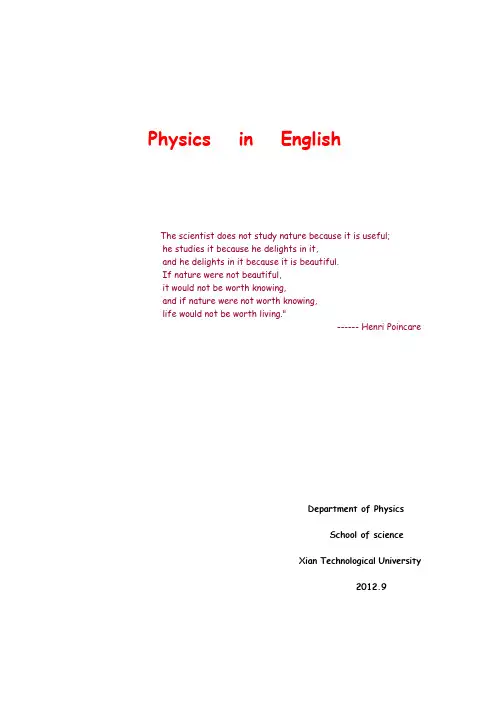
Physics in EnglishThe scientist does not study nature because it is useful;he studies it because he delights in it,and he delights in it because it is beautiful.If nature were not beautiful,it would not be worth knowing,and if nature were not worth knowing,life would not be worth living."------ Henri PoincareDepartment of PhysicsSchool of scienceXian Technological University 2012.9Chapter 1 What is Physics?Physics is natural science studying nature's LawsPhysics was called natural philosophy and fundamental science.The history of physicsThe history of physics encompasses two broad time periods in which classical physics and modern physics developed. Classical physics developed between 1600 and 1900. It embraces the general areas of physics known as mechanics, thermodynamics, and electromagnetism, culminating in relativity. Modern physics began developing between about 1890 and 1930, when it was realized that classical physics could not account for the newly discovered behavior of nature at the atomic and molecular level. Modern physics includes the theory of relativity as well as quantum mechanics and most of the subsequent new physics discovered and developed during the 20th century.Classical physicsClassical physics includes the traditional branches and topics that were recognized and well-developed before the beginning of the 20th century—classical mechanics, optics, thermodynamics, and electromagnetism. Classical mechanics is concerned with bodies acted on by forces and bodies in motion and may be divided into statics (study of the forces on a body or bodies at rest), kinematics (study of motion without regard to its causes), and dynamics (study of motion and the forces that affect it); Acoustics, the study of sound, is often considered a branch of mechanics because sound is due to the motions of the particles of air or other medium through which sound waves can travel and thus can be explained in terms of the laws of mechanics. Among the important modern branches of acoustics is ultrasonics, the study of sound waves of very high frequency beyond the range of human hearing. Optics, the study of light, is concerned not only with visible light but also with infrared and ultraviolet radiation, which exhibit all of the phenomena of visible light except visibility, e.g., reflection, refraction, interference, diffraction, dispersion, and polarization of light. Heat is a form of energy, the internal energy possessed by the particles of which a substance is composed; thermodynamics deals with the relationships between heat and other forms of energy. Electricity and magnetism have been studied as a single branch of physics since the intimate connection between them was discovered in the early 19th century; an electric current gives rise to a magnetic field and a changing magnetic field induces an electric current. Electrostatics deals with electric charges at rest, electrodynamics with moving charges, and magnetostatics with magnetic poles at restThe Emergence of Classical PhysicsClassical mechanics has its roots in the work of Johannes Kepler, who, between 1600 and 1619, became the first person to describe quantitatively and accurately the elliptic paths of the planets around the Sun.The problem of the shape of the planetary orbits was not easy to solve, because all historical observations of the planets were made from the Earth, itself a moving planet. Although a crude heliocentric(Sun-centered) model of the solar system using circular orbits was proposed by the Greek astronomer Aristarchus in the third century B.C. and resurrected by Copernicus in 1542,the planetary positions predicted by Copernicus were not as accurate as those found using Ptolemy's complicated geocentric (Earth-centered} model of the second century A.D.The pure Copernican model was inaccurate because Copernicus refused to abandon the flawed concept of early Greek thought that the natural path of a moving "perfect" celestial object, such as a planet, had to be in the shape of the "perfect" geometrical figure---a circle---with the planet moving at constant speed. a scientist living at the time of Copernicus would have been forced to reject the Copernican theory with its circular planetary orbits, since they did not account for the observed motions of the planets as accurately as the existing, but more complicated, geocentric theory of Ptolemy.The change from the accurate but complex Ptolemaic geocentric model of the solar system to the accurate and simple heliocentric model of Kepler illustrates the characteristics of a good theory. With Kepler's work, accuracy and simplicity blossomed simultaneously from the heliocentric hypothesis. Kepler's model and mathematical methods began the development of physics as we know it. His work was a watershed of quantitative thought and a new worldview.Observation of nature and experimental results typically precede the general theories that account for them. The extensive observations of the planets by Tycho Brahe just prior to 1600 provided Kepler with the data he needed to model the solar system accurately and precisely。
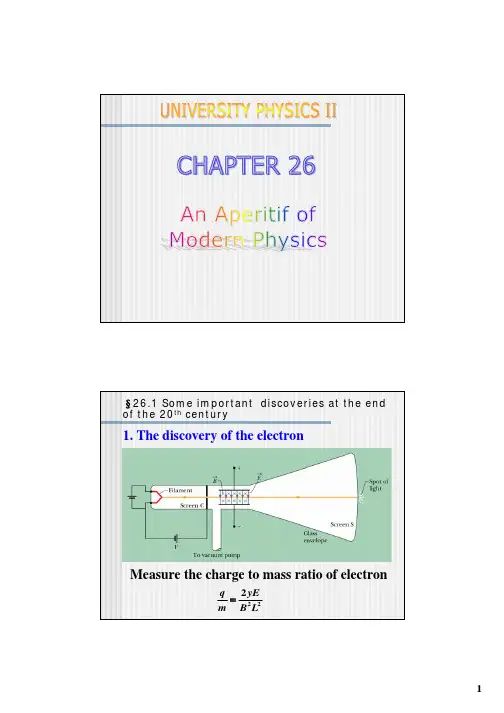
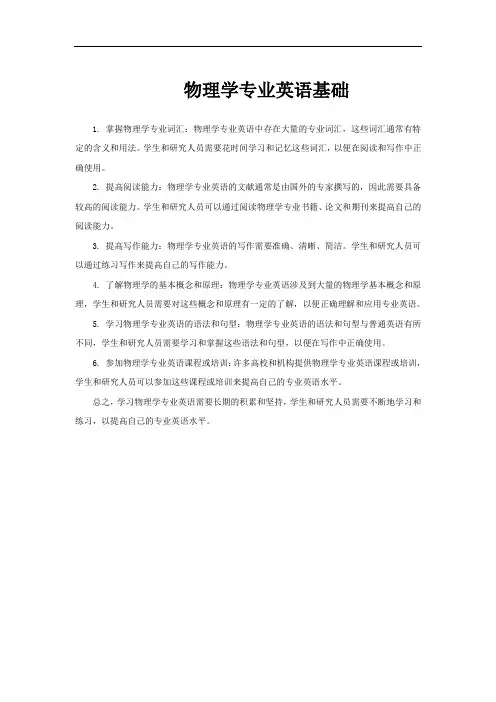
物理学专业英语基础
1. 掌握物理学专业词汇:物理学专业英语中存在大量的专业词汇,这些词汇通常有特定的含义和用法。
学生和研究人员需要花时间学习和记忆这些词汇,以便在阅读和写作中正确使用。
2. 提高阅读能力:物理学专业英语的文献通常是由国外的专家撰写的,因此需要具备较高的阅读能力。
学生和研究人员可以通过阅读物理学专业书籍、论文和期刊来提高自己的阅读能力。
3. 提高写作能力:物理学专业英语的写作需要准确、清晰、简洁。
学生和研究人员可以通过练习写作来提高自己的写作能力。
4. 了解物理学的基本概念和原理:物理学专业英语涉及到大量的物理学基本概念和原理,学生和研究人员需要对这些概念和原理有一定的了解,以便正确理解和应用专业英语。
5. 学习物理学专业英语的语法和句型:物理学专业英语的语法和句型与普通英语有所不同,学生和研究人员需要学习和掌握这些语法和句型,以便在写作中正确使用。
6. 参加物理学专业英语课程或培训:许多高校和机构提供物理学专业英语课程或培训,学生和研究人员可以参加这些课程或培训来提高自己的专业英语水平。
总之,学习物理学专业英语需要长期的积累和坚持,学生和研究人员需要不断地学习和练习,以提高自己的专业英语水平。
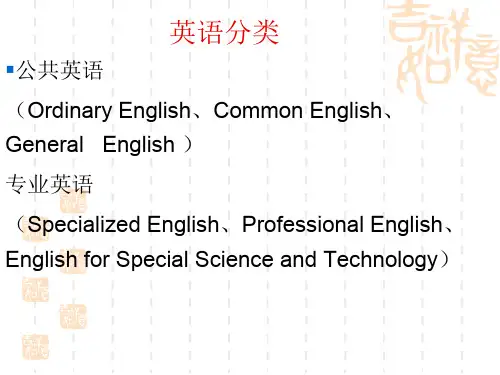

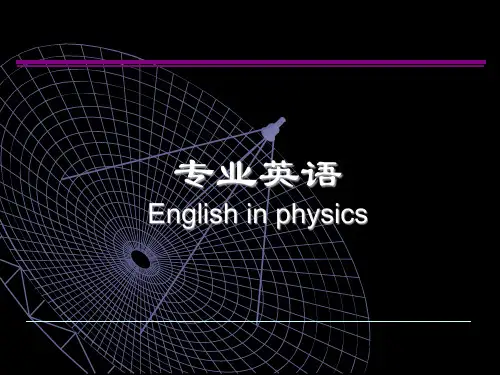
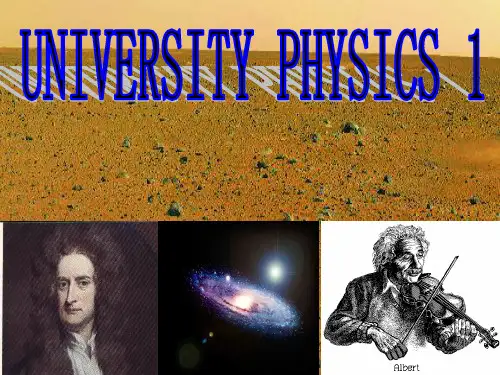
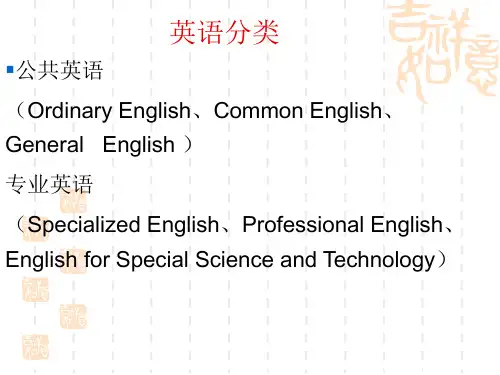
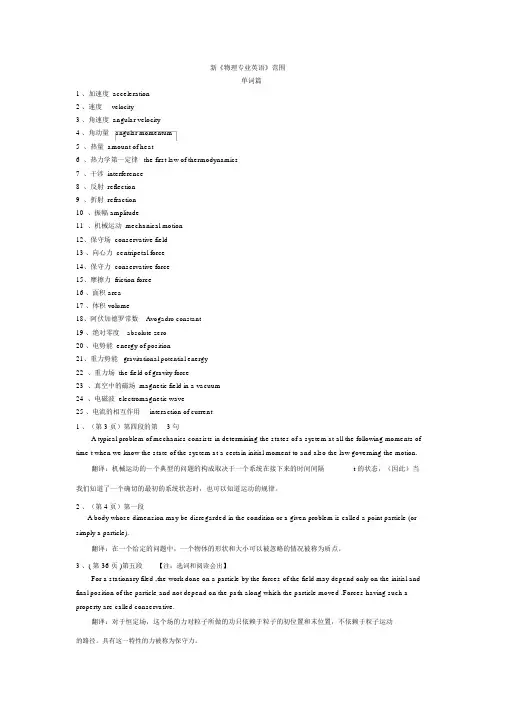
新《物理专业英语》范围单词篇1 、加速度 acceleration2 、速度velocity3 、角速度 angular velocity4 、角动量angular momentum5、热量 amount of heat6、热力学第一定律 the first law of thermodynamics7、干涉 interference8、反射 reflection9、折射 refraction10、振幅 amplitude11、机械运动 mechanical motion12、保守场 conservative field13 、向心力 centripetal force14、保守力 conservative force15、摩擦力 friction force16 、面积 area17 、体积 volume18、阿伏加德罗常数Avogadro constant19 、绝对零度absolute zero20 、电势能 energy of position21、重力势能gravitational potential energy22、重力场 the field of gravity force23、真空中的磁场 magnetic field in a vacuum24、电磁波 electromagnetic wave25 、电流的相互作用interaction of current1 、(第 3 页)第四段的第 3 句A typical problem of mechanics consists in determining the states of a system at all the following moments of time t when we know the state of the system at a certain initial moment to and also the law governing the motion.翻译:机械运动的一个典型的问题的构成取决于一个系统在接下来的时间间隔t 的状态,(因此)当我们知道了一个确切的最初的系统状态时,也可以知道运动的规律。
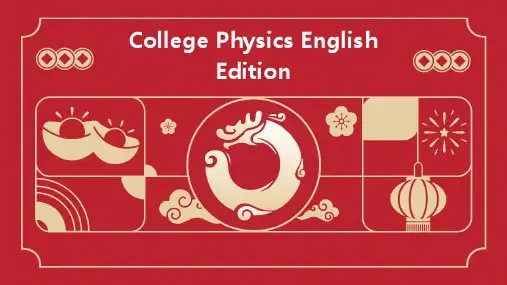
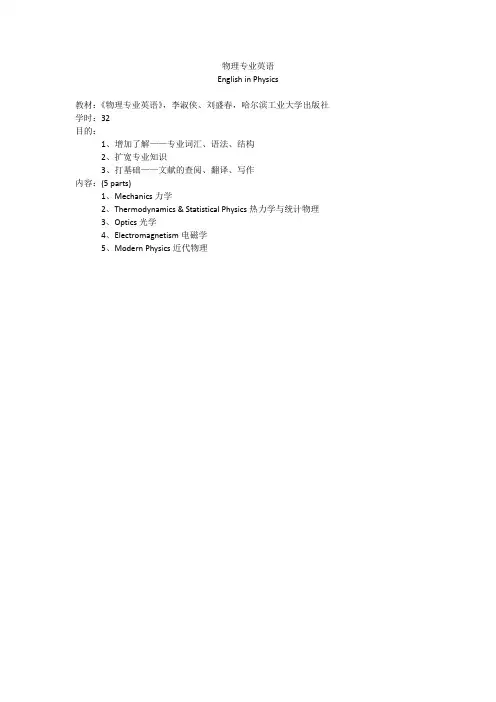
物理专业英语English in Physics教材:《物理专业英语》,李淑侠、刘盛春,哈尔滨工业大学出版社学时:32目的:1、增加了解——专业词汇、语法、结构2、扩宽专业知识3、打基础——文献的查阅、翻译、写作内容:(5 parts)1、Mechanics力学2、Thermodynamics & Statistical Physics热力学与统计物理3、Optics光学4、Electromagnetism电磁学5、Modern Physics近代物理Part 1 The physical fundamentals of mechanicsCharpter1 kinematics§1-0 Prologuequestions:Can you briefly describe mechanics in your mind?Study the motion of the material bodiesHave long historyTremendous growth by Galileo and NewtonWhat can we do applying the principles of mechanics?Predict motions \ analyse motions and explain the causeWhy mechanics is most important branch of physics?The first complete branch,furnish the basic concepts of whole physics, influence theother branches.passages:✧Now we apply some principles to the motions of artificial satellites such as anorbiting Space Shuttle. In general, the principles of mechanics can be applied toi. The motions of celestial objects so as to accurately predict events, in somecases many years before they happen, for example, the return of the Halley’scomet;ii. The motions of ordinary objects on Earth , for example, an automobile or a thrown baseball;iii. The behavior of atoms, atomic particles, and subatomic particles, withconsiderable success.words:●kinematics[,kini'mætiks, kai]n. the branch of mechanics concerned with motion withoutreference to force or mass运动学;动力学●celestial [si'lestjəl] adj. adj.1. of or relating to the sky 2. relating to or inhabiting a divine heaven 3.of heaven or the spirit 天上的,天空的●space shuttle n. a reusable spacecraft with wings for a controlled descent through the Earth'satmosphere太空飞船●comet ['kɔmit] n. (astronomy) a relatively small extraterrestrial body consisting of a frozen massthat travels around the sun in a highly elliptical orbit●differentiate [,difə'renʃieit] v. 1. mark as different 2. be a distinctive feature, attribute, or trait;sometimes in a very positive sense 3. calculate a derivative; take the derivative4. becomedifferent during development cells differentiate 5. evolve so as to lead to a new species or develop in a way most suited to the environment 6. become distinct and acquire a different charactervi. 区分,区别vt. 区分,区别§1-1Mechanical motionquestions:●What must we introduce or consider when we describe the mechanical motion?●Why do we usually study the idea models, such as particle and rigid body?●When a body we study is regarded as a point particle ? or a rigid body?●How can we describe the motion of a body or system ?●How many kinds of the motion of the rigid body? And what they are?●Can you describe the Cartesian coordinates as a example in this section?Passage:✧It was indicated above that motion in mechanics is defined as the change in themutual arrangement of the bodies. If we imagine a separate isolated body in aspace where no others are present, then we cannot speak of the motion of thebody because there is nothing with respect to which the body could change its position. It thus follows that if we intend to study the motion of a body, then we must indicate with respect to what other bodies the given motion occurs.✧To describe the motion of a body means to indicate for every moment of thetime the position of the body in space and its velocity. To set the state of amechanical system, we must indicate the positions and the velocities of all thebodies forming the system. A typical problem of mechanics consists indetermining the states of a system at all the following moments of time t whenwe know the state of the system at a certain initial moment t0 and also the laws governing the motion.✧It is simpler to treat a point particle than an extended body. We shall thereforefirst study the mechanics of a particle, and then go over to the mechanics of arigid body. We shall start with kinematics, and then delve into dynamics. Weremind our reader that kinematics studies the motion of bodies without regardto what causes this motion. Dynamics studies the motion of bodies with a view to what causes this motion to have the nature it does, i.e. with a view to theinteractions between bodies.Word:timepiece ['taimpi:s] n. a measuring instrument or device for keeping time 计时器stationary ['steiʃənəri] adj. 1. standing still 2. not capable of being moved 固定的;静止的;定居的;常备军的reference frame n. a system that uses coordinates to establish position参考系,参考坐标系constant ['kɔnstənt]adj. 1. persistent in occurrence and unvarying in nature 2. continually recurring or continuing without interruption 3. steadfast in purpose or devotion or affection 4.uninterrupted in time and indefinitely long continuing n.1. a quantity that does not vary2. anumber representing a quantity adj. 不变的;恒定的;经常的n. [数] 常数;恒量corridor ['kɔridɔ:] n. an enclosed passageway; rooms usually open onto it走廊disengage [,disin'ɡeidʒ] v. release from something that holds fast, connects, or entangles 使脱离;解开;解除disengage from 使…从…脱离(或解脱、解除):deform [di'fɔ:m] v. 1. make formless 2. twist and press out of shape 3. cause (a plastic object) to assume a crooked or angular form 4. become misshapen 5. alter the shape of(something) by stress 6. assume a different shape or form vt. 使变形;使成畸形vi. 变形;变畸形adj. 畸形的;丑陋的Cartesian [kɑ:'tiziən] adj. of or relating to Rene Descartes or his works adj. 笛卡尔哲学的;笛卡尔的cartesian coordinate [数学]笛卡尔坐标cartesian coordinate system 笛卡儿坐标系统cartesian product 笛卡儿积cartesian space 直角坐标空间;欧几里得空间;笛卡儿空间rectangular ['rek'tæŋɡjulə] adj. 1. having four right angles 2. having a set of mutually perpendicular axes; meeting at right angles adj. 矩形的;成直角的lattice ['lætis] n. 1. an arrangement of points or particles or objects in a regular periodic pattern in 2 or 3 dimensions 2. small opening (like a window in a door) through which business can be transacted 3. framework consisting of an ornamental design made of strips of wood or metal[晶体] 晶格;格子;格架rod [rɔd] n. 1. a linear measure of 16.5 feet 2. a long thin implement made of metal or wood3. any rod-shaped bacterium4. a square rod of land5. visual receptor cell sensitive to dimlight 6. a gangster's pistol 棒;惩罚;枝条;权力identical [ai'dentikəl]adj. 同一的;完全相同的n. 完全相同的事物scale1 [skeil] n.1. an ordered reference standard 2. relative magnitude 3. the ratio between the size of something and a representation of it v.1. measure by or as if by a scale 2. pattern, make, regulate, set, measure, or estimate according to some rate or standard3. take by attacking withscaling ladders 4. reach the highest point of 5. measure with or as if with scales 6. size or measure according to a scale n.规模;比例;鳞;刻度;天平;数值范围v. 测量;依比例决定graduate ['ɡrædʒuət, 'ɡrædjueit] v 1. receive an academic degree upon completion of one's studies 2. make fine adjustments or divide into marked intervals for optimal measuringvt. 授予…学位;分等级;标上刻度synchronize ['siŋkrənaiz] v.1. make synchronous and adjust in time or manner 2. happen at the same time3. make (motion picture sound) exactly simultaneous with the action 4. arrange orrepresent events so that they co-occur 5. operate simultaneously 6. cause to indicate the same time or rate vt. 使……合拍;使……同步vi. 同步;同时发生go over 复习,重温;仔细检查;转变;润色delve [delv] v. turn up, loosen, or remove earthvi. 钻研;探究;挖i.e. 是拉丁文id est [id'est]的缩写,它的意思就是“那就是说,换句话说”,等同于“thatis,in other words” ,目的是用来进一步解释前面所说的观点。